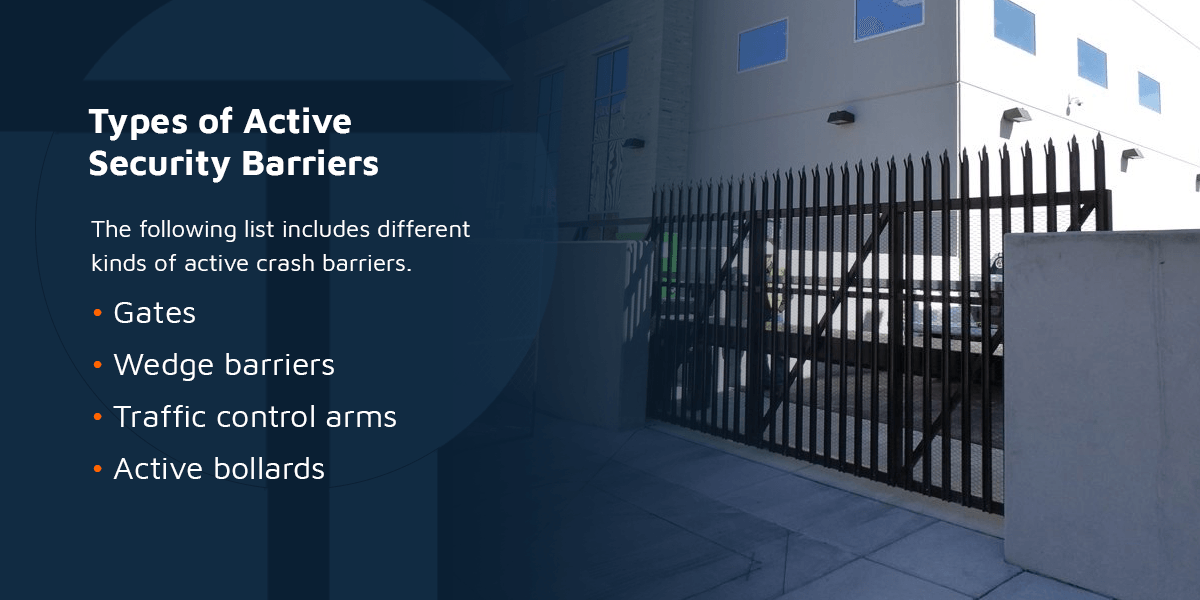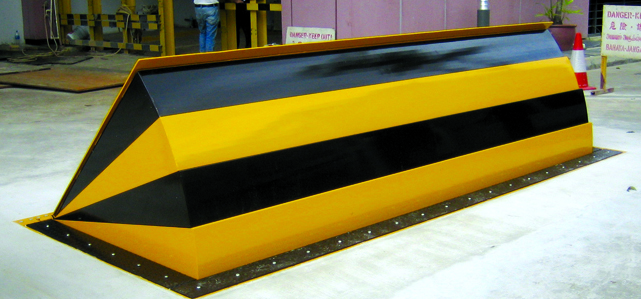9 Easy Facts About Wedge Barriers Explained
Wiki Article
The Greatest Guide To Wedge Barriers
Table of ContentsWhat Does Wedge Barriers Mean?The Definitive Guide to Wedge Barriers

14 and the surface 12 to which the obstacle 10 is safeguarded may be made from concrete - Wedge Barriers. 2, the obstacle 10 is installed to or consists of an anchor or subframe (e. g., anchor 30 displayed in FIG. 2 )protected below the surface 12. As an example, the bather 10 may be bolted to the support or protected to the support by other mechanical fasteners. In the illustrated embodiment, the barrier 10 includes a wedge plate 16, that includes a portion that is substantially identical with the surface 12 when the obstacle 10 is in the retracted setting. Simply put, cars or people may overlook the obstacle 10 when the obstacle 10 is in the retracted position and experience minor elevation about the surface 12 while on the barrier 10. As discussed carefully listed below, when the obstacle 10 remains in the released setting, the wedge plate 16 is held and supported in an increased position by a training system of the obstacle 10. Additionally, the components 18 might be bolted or otherwise mechanically coupled to one another. In this fashion, repair service or substitute of one or even more elements 18 may be streamlined and structured. That is, repair or substitute of single components 18 might be done faster, conveniently, and expense effectively. FIG. In specific embodiments, the anchor 30 may be a steel framework including plates, light beams(e. g., I-beams ), and/or other structures that are safeguarded within the foundation 14, which may be concrete. At the surface 12, a top side 28 of the anchor 30 may go to least partly revealed , thereby making it possible for the accessory of the obstacle 10 to the support 30. g., threaded openings)in one or more light beams or plates of the anchor 30 may be exposed to the surface 12. In this way, screws 32 or other mechanical fasteners might be utilized to protect the obstacle 10 to the anchor 30. As the obstacle 10 is mounted to the surface area 12 of the structure 14, collection of particles and other product underneath the barrier may be minimized, and parts of the bather 10 might not be subjected to below grade settings. As indicated by reference numeral 52, the lifting system 50 includes parts got rid of underneath the wedge plate 16. For example, the parts 52 below the wedge plate 16 may consist of an electromechanical actuator, a camera, one or even more cam surface areas, etc. Additionally, the lifting mechanism 50 includes a spring assembly 54
The spring rod 58 is combined to a camera(e. g., camera 80 received FIG. 4) of the training device 50. The springtimes 60 disposed concerning the springtime pole 58 are held in compression by springtime sustains 62, consisting of a dealt with spring support 64. That is, the fixed springtime support 64 is taken care of loved one to the structure 14 et cetera of the bather try this website 10.
How Wedge Barriers can Save You Time, Stress, and Money.
The staying pressure applied to the cam webcam deploy release wedge plate 16 may might provided offered an electromechanical actuator 84 or other various other. The springtime assembly 54 and the actuator 84(e. Wedge Barriers. g., electromechanical actuator)might run together to equate the web cam and lift the wedge plate 16.
As mentioned above, the springtime assembly 54 applies a consistent pressure on the web cam, while the electromechanical actuator might be controlled to exert a variable pressure on the cam, thereby enabling the training and decreasing( i. e., releasing and withdrawing )of the wedge plate 16. In certain personifications, the constant pressure used by the springtime setting up 54 may be adjustable. g., electromechanical actuator) is handicapped. As will certainly be valued, the springtime setting up 54 may be covered and shielded from particles or various other aspects by a cover plate(e. g., cover plate 68 shown in FIG. 4) that might be substantially flush with the elevated surface 38 of the foundation 14. As mentioned above, in the deployed setting, the wedge plate 16 serves to block gain access to or travel beyond the obstacle 10. The obstacle 10(e. g., the wedge plate 16 )may block pedestrians or cars from accessing a home or pathway. As talked about over, the barrier 10 is affixed to the anchor 30 safeguarded within the foundation 14,

front brackets 71. As a result, the link settings up 72 might pivot and turn to make it possible for the collapse and extension of the linkage assemblies 72 throughout retraction and release of the bather 10. The affiliation assemblies 72 cause motion of the wedge plate 16 to be limited. If an automobile is traveling towards the released wedge plate 16(e. For example, in one scenario, the safety and security legs 86 might be extended duringmaintenance of the barrier 10. When the safety and security legs 86 are released, the safety and security legs 86 sustain the weight of the wedge plate 16 versus the surface area 12. Because of this, the lifting device 50 might be shut down, serviced, gotten rid of, changed, etc. FIG. 5 is partial viewpoint sight of a personification of the surface-mounted wedge-style barrier 10, illustrating the webcam 80 and the webcam surface areas 82 of the lifting device 50. Especially, 2 camera surface areas 82, which are referred to as lower camera surfaces 83, are positioned listed below the camera 80. The reduced web cam surfaces 83 might be dealt with to the surface 12 (e. For instance, the reduced camera surface areas 83 and the installing plate 85 may create a solitary piece that is secured to the support 30 by screws or other mechanical fasteners. Additionally, 2 camera surfaces 82, which are referred to as upper cam surface areas 87, are positioned above the web cam 80 and paired to (e. In various other personifications, stepping in layers or plates may be placed between the surface area 12 and the reduced web cam surface areas 83 and/or the wedge plate 16 and the upper web cam surface areas 87 As click here to read stated over, the camera 80 equates along the web cam surfaces 82 when the wedge plate 16 is raised from the pulled back position to the deployed position. In addition, as discussed over, the springtime setting up 54 (see FIG. 3 )may offer a force acting upon the cam 80 in the direction 102 through spring rod 58, which may decrease the pressure the electromechanical actuator 84 is called for to relate to the cam 80 in order to actuate and lift the wedge plate 16. 1 )to the released placement(see FIG. 4). As shown, the web cam 80 includes track wheels 104(e. g., rollers), which contact and convert along the web cam surfaces 82 throughout operation.
Report this wiki page